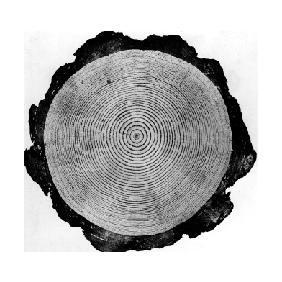D. Growth Rings
In most species in temperate climates, the difference between wood that is formed early in a growing season and that formed later is sufficient to produce well-marked annual growth rings (Fig. 2–2) . The age of a tree at the stump or the age at any cross section of the trunk may be determined by counting these rings. However, if the growth in diameter is interrupted, by drought or defoliation by insects for example, more than one ring may be formed in the same season. In such an event, the inner rings usually do not have sharply defined boundaries and are termed false rings. Trees that have only very small crowns or that have accidentally lost most of their foliage may form an incomplete growth layer, sometimes called a discontinuous ring. The inner part of the growth ring formed first in the growing season is called earlywood and the outer part formed later in the growing season, latewood. Actual time of formation of these two parts of a ring may vary with environmental and weather conditions. Earlywood is characterized by cells with relatively large cavities and thin walls. Latewood cells have smaller cavities and thicker walls. The transition from earlywood to latewood may be gradual or abrupt, depending on the kind of wood and the growing conditions at the time it was formed. Growth rings are most readily seen in species with sharp contrast between latewood formed in one year and earlywood formed in the following year, such as in the native ring porous hardwoods ash and oak, and in softwoods like southern pines. In some other species, such as water tupelo, aspen, and sweetgum, differentiation of earlywood and latewood is slight and the annual growth rings are difficult to recognize. In many tropical regions, growth may be practically continuous throughout the year, and no well-defined growth rings are formed. When growth rings are prominent, as in most softwoods and ring porous hardwoods, earlywood differs markedly from latewood in physical properties. Earlywood is lighter in weight, softer, and weaker than latewood. Because of the greater density of latewood, the proportion of latewood is sometimes used to judge the strength of the wood. This method is useful with such species as the southern pines, Douglas-fir, and the ring-porous hardwoods (ash, hickory, and oak).
Fig. 2-2
